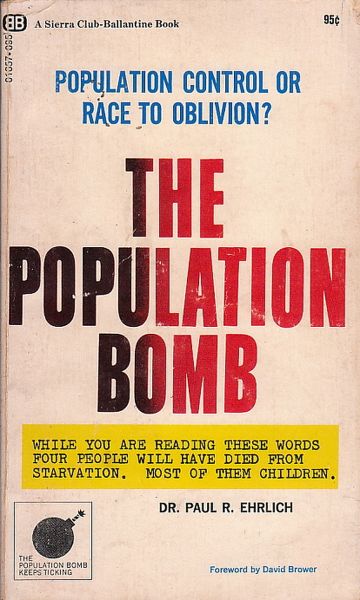Make Room! Make Room!
The Population Bomb
By Paul R. Ehrlich

19 Mar, 2023
Paul R. Ehrlich’s1 1968 The Population Bomb is an alarmist text on the dangers of unchecked population growth.
The Population Bomb (or at least the 1970 edition I found at Dana Porter Arts Library) begins with this straight-forward assertion.
The battle to feed all of humanity is over. In the 1970s hundreds of millions of people will starve to death in spite of any crash programs embarked upon now. At this late date nothing can prevent a substantial increase in the world death rate.
What reasoning led Ehrlich to this conclusion and what solutions did he propose?
Chapter 1: The Problem
There are too many people; there are more people every day; there is too little food; the food supply is not growing at the same rate as people are having babies. One consequence: rampant environmental degradation.
Two details jump out: this was clearly written before the EPA was created and Ehrlich expected Baby Boomers to have as many kids each as their parents had.
Chapter 2: The Ends of the Road
Ehrlich provides three scenarios for the future: one in which unchecked population growth leads to a limited nuclear exchange, one in which it leads to a catastrophic nuclear exchange, and a more hopeful one in which Malthusian calamity is limited for the most part to the undeveloped world, allowing the developed nations to create institutions that will prevent a repeat.
Chapter 3: What is Being Done
Ehrlich outlines the useless, sometimes actively counter-productive, population policies of the 1960s.
Ehrlich particularly dislikes Catholics. I don’t think it ever occurred to him to determine if in fact Catholics follow papal decrees that they find personally inconvenient.
Chapter 4: What Needs to Be Done
Draconian population control and lots of it! As well, large swaths of the Earth will have to be written off as beyond any reasonable means to avert INEVITABLE MALTHUSIAN DOOM.
Chapter 5: What Can You Do?
Ehrlich provides a diverse assortment of tactics readers can use to sway people to the cause of draconian population control.
While one cannot help but notice the alarm Ehrlich felt when surrounded by brown people in India and the ease with which he consigns Africa and Asia to catastrophic famine, he does go out of his way to reject eugenics-founded arguments.
Chapter 6: What If I’m Wrong?
Population control would make things better in general so even if Ehrlich is wrong, he is right.
Cursory research suggests that Ehrlich’s resistance to admitting error proved to be Herculean.
~oOo~
Looking back from the perspective of 2023, we can see that Ehrlich’s predictions were spectacularly wrong.
Developments Ehrlich thought were unlikely nevertheless came to be: the food supply was expanded and people across the planet have to a surprising degree reduced birthrates without the need for mass sterilization or mommy hunts.
Malthusian panics are a recurring phenomenon, and this book was part of a much greater panic2. Harry Harrison’s dystopian Make Room! Make Room! predated The Population Bomb by two years. Nevertheless, I think it’s safe to say that The Population Bomb influenced a lot of SF authors: a number of novels come to mind in which Ehrlich’s third scenario features. This is due to a few things Ehrlich got right:
- His book is short.
- He makes his points clearly.
- He has a dab hand at presenting counter-arguments as counter-factual at worst or hopelessly optimistic at best.
- Humans seem to have an inherent desire to control other people’s reproductive behavior and this text plays into that.
One might be tempted to dismiss The Population Bomb as an amusing relic of a bygone era. A quick look at Goodreads and Amazon turns up glowing reviews undeterred by Asia’s inconsiderate failure to starve to death. The book still has its fans.
The Population Bomb is available here (Amazon US) and here (Amazon Canada) but otherwise appears to be out of print.
1: Sources suggest that the book was written by Paul R. Ehrlich and Anne Howland Ehrlich. Only one of them got cover credit.
2: Ehrlich’s panic seems to have been set off by a very similar experience to the one that inflamed Heinlein’s worry about population growth. Ehrlich visited a crowded undeveloped nation. The moral here: never allow middle-class white Americans to travel outside of carefully selected regions.
